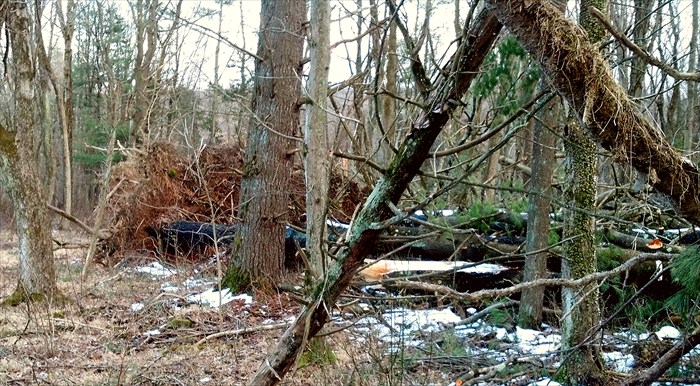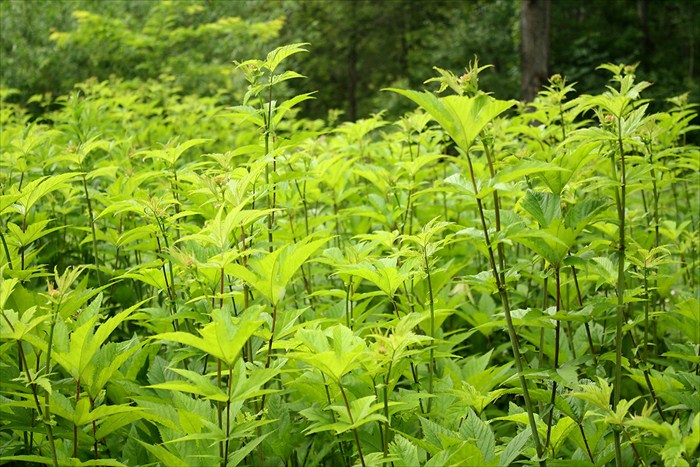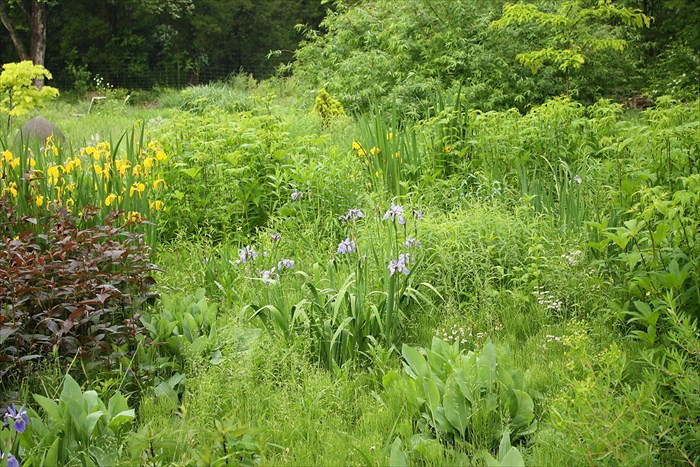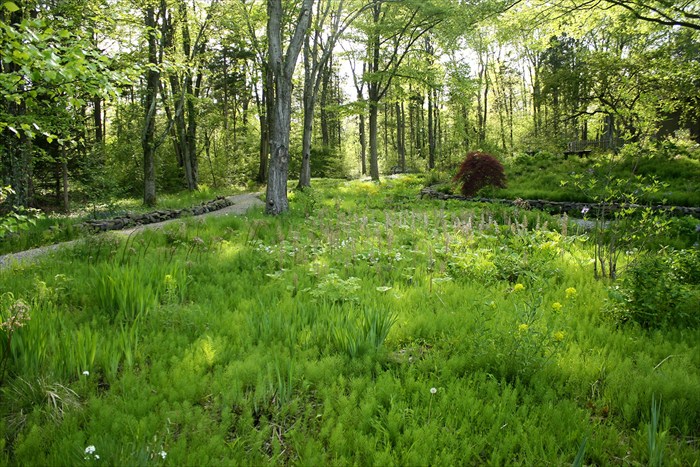Ecological disruption: Has Travis Beck been in my garden?

Ecological Disturbance
I've been thinking about the seventeen tall white pines that fell just outside my garden, casualties of Hurricane Sandy, leaving a giant, linear wood pile on the southern border. Thinking specifically about how to accommodate my garden to their fallen presence and, in the longer term, to the effects their absence will have on the garden and the surrounding woods.The garden will certainly get more southerly light now, but other less immediately obvious and long-term ecological changes will be set in motion too.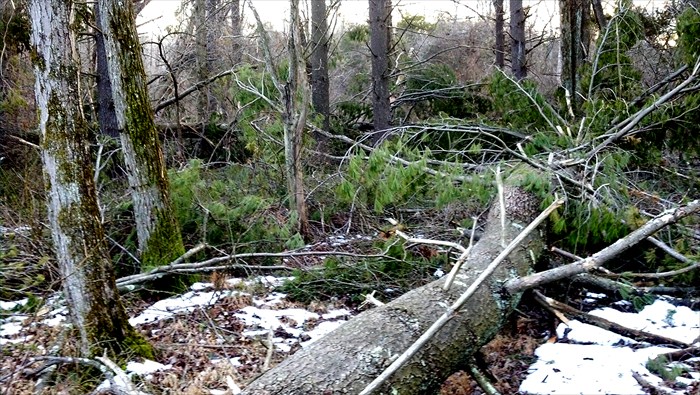 Such "disasters" in the garden are not necessarily bad. Disturbance brings change--and opportunity. My garden is itself a product of a major ecological disturbance I initiated--by cutting down a scraggly cedar wood (Juniperus virginiana) and replacing it with a "simulacrum" of a wet prairie, meaning a garden modeled on wet prairie ecology, but planted with a mixture of prairie and non-prairie species, many of exotic origin, that nevertheless grow in self-sustaining communities because appropriate to my conditions. Disruption resulted in changed conditions, creating an open glade, and making it possible for me to create a prairie garden.
Such "disasters" in the garden are not necessarily bad. Disturbance brings change--and opportunity. My garden is itself a product of a major ecological disturbance I initiated--by cutting down a scraggly cedar wood (Juniperus virginiana) and replacing it with a "simulacrum" of a wet prairie, meaning a garden modeled on wet prairie ecology, but planted with a mixture of prairie and non-prairie species, many of exotic origin, that nevertheless grow in self-sustaining communities because appropriate to my conditions. Disruption resulted in changed conditions, creating an open glade, and making it possible for me to create a prairie garden.
Travis Beck's Principles of Ecological Landscape Design
I just finished a stunning new book, Travis Beck's Principles of Ecological Landscape Design, where I've been reading about the concept of "disturbance," in the ecological sense, and gaining a better understanding of the opportunities and potential benefits of such disturbance--through changed conditions that allow new communities of plants to take hold, using new open space and increased sunlight, and opening the potential for increased diversity and resilience in the plant community.Thomas Rainer's recent posts on his notable blog grounded design introduced me to Travis Beck's new book, a book that, I agree with Rainer, may well become a classic in landscape design. In my view, this book will stand beside another landmark work, one unfortunately not widely known in this country, Die Stauden und ihre Lebensbereich (Perennials and their Garden Habitats) first published in Germany in 1981 by Richard Hansen and Friedrich Stahl, which greatly advanced understanding of planting appropriate to many different ecologies or "garden habitats." This was not a new concept even in 1981, but Hansen's and Stahl's work, an outgrowth of decades of research growing perennials in controlled conditions, and containing detailed information on a vast number of plants and their appropriate habitats,was very influential on contemporary thinking, and paved the way to new directions in garden design, among them the naturalistic "new perennials" movement epitomized by Piet Oudolf and other designers. It's an essential resource for anyone trying to match plants to microecologies.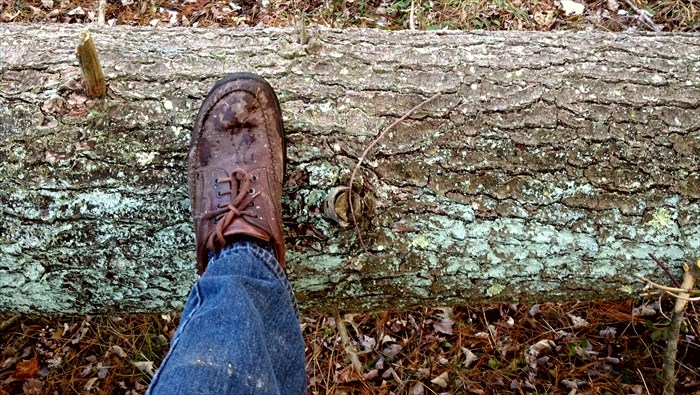 While Perennials and their Garden Habitats sets the stage for ecological planting through decades of practical observation of plants and their habitats, and broadened the understanding of plant communities and plant sociology (which plants like company, and what company, and which don't tolerate others), it was limited primarily to gardens. Beck's book has a much broader ecological scope as well as the benefit of several decades of additional thinking and research in ecological science since publication of the earlier work.
While Perennials and their Garden Habitats sets the stage for ecological planting through decades of practical observation of plants and their habitats, and broadened the understanding of plant communities and plant sociology (which plants like company, and what company, and which don't tolerate others), it was limited primarily to gardens. Beck's book has a much broader ecological scope as well as the benefit of several decades of additional thinking and research in ecological science since publication of the earlier work. Beck addresses changes that occur over time, the importance of disturbance in introducing ecological change and diversity, the role of diversity in creating resilient plantings, the ways in which ecologies become resilient and able to respond to change, sometimes highly disruptive change, in positive ways (from the human or other perspectives), how we must learn to manage the ecologies of the earth (since we have changed all of them and have no choice in the matter), perhaps even developing novel, human-made ecosystems--and ultimately the need and the possibility of gardening the earth. It is a deeply optimistic book. (The book covers many subjects--the chapter on soil is a revelation--far too many to cover in this post. Get a copy. You won't regret it.)
Beck addresses changes that occur over time, the importance of disturbance in introducing ecological change and diversity, the role of diversity in creating resilient plantings, the ways in which ecologies become resilient and able to respond to change, sometimes highly disruptive change, in positive ways (from the human or other perspectives), how we must learn to manage the ecologies of the earth (since we have changed all of them and have no choice in the matter), perhaps even developing novel, human-made ecosystems--and ultimately the need and the possibility of gardening the earth. It is a deeply optimistic book. (The book covers many subjects--the chapter on soil is a revelation--far too many to cover in this post. Get a copy. You won't regret it.)
Diversity and Novel Ecosystems
This is where I find the relevance of Beck's book to my garden. Yes, Travis Beck has been in my garden, but only in my head.
I found the discussion of ecological disturbance in Principals of Ecological Landscape Design of special interest because I'm looking a major disturbance in the face right now. My garden is all about disturbance and created diversity--a novel ecosystem, if you will. Perhaps not in the same sense Beck writes about, but sufficiently close that I find a theoretical basis for my approach to gardening here. My garden at Federal Twist had its origin in centuries of disturbance. In 1965 it was a meadow; through lack of mowing it evolved into a juniper wood, and was well on its way to becoming a Beech, Hickory, Maple, Oak hardwood forest when we bought our house and cut down seventy or eighty trees to make space for a garden. Talk about ecological disruption!Here is how my "garden" looked in the winter of 2005, before the trees were removed to make a clearing in the woods. And here is how it looked in 1965, when the house looked out onto a meadow, albeit a meadow dotted with then small junipers.
And here is how it looked in 1965, when the house looked out onto a meadow, albeit a meadow dotted with then small junipers.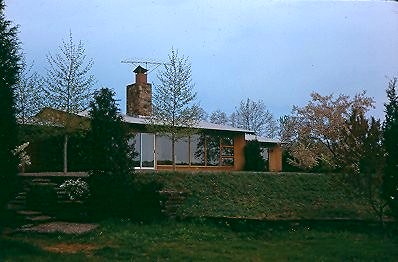
Planting in Rough Grass
After clearing the land, I began introducing plants, some native, some exotic. I used as models the books I was reading by Noel Kingsbury, which elaborated on the concept of plant communities (a lesson passed quite generously from Hansen and Stahl) and approaches to planting practices by such cutting edge garden designers as Piet Oudolf and Cassian Schmidt, head of Hermannshof Garden in Germany. Kingsbury's work introduced me to Hansen and Stahl's work, leading me to search out a hard-to-find copy of Perennials and their Garden Habitats, which became my guide for plant selection (with some adaptation for my different continent, climate, and difficult soil conditions).So, as I said, we cut seventy or eighty trees, cleared the land of the most obvious detritus, and burned when necessary, essentially returning at least part of the land to the 1965 baseline. Not really--that would have been impossible--but returning to it the potential to become a meadow-like environment.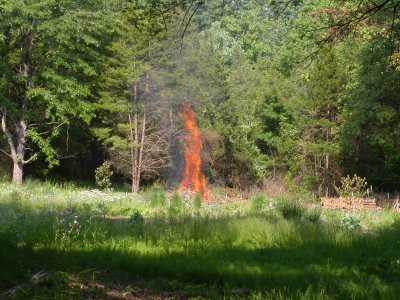 I did not till the land, remove any of the native herbaceous vegetation, or make any attempts to improve the soil. It remains heavy, wet, with poor drainage. Following Kingsbury's advice in The New Perennial Garden (Francis Lincoln, 1996), I started planting directly into the existing matrix of plants, closely following his advice on planting perennials directly into rough grass: in certain difficult circumstances, Kingsbury writes, "the best solution is to plant really tough, often large, perennials which will be able to compete with vigorous grasses and weeds on their own terms... "
I did not till the land, remove any of the native herbaceous vegetation, or make any attempts to improve the soil. It remains heavy, wet, with poor drainage. Following Kingsbury's advice in The New Perennial Garden (Francis Lincoln, 1996), I started planting directly into the existing matrix of plants, closely following his advice on planting perennials directly into rough grass: in certain difficult circumstances, Kingsbury writes, "the best solution is to plant really tough, often large, perennials which will be able to compete with vigorous grasses and weeds on their own terms... "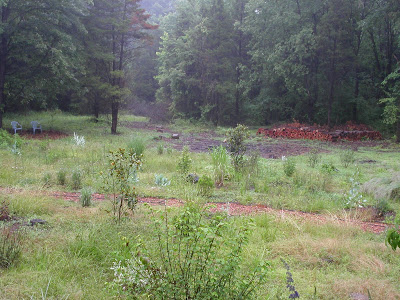 "... a meadow of sorts will be the result--much coarser, perhaps, than the ideal but still potentially exuberantly colourful. This is the kind of planting that some garden designers call a prairie, although the plants may not all be true prairie species."
"... a meadow of sorts will be the result--much coarser, perhaps, than the ideal but still potentially exuberantly colourful. This is the kind of planting that some garden designers call a prairie, although the plants may not all be true prairie species."
My Wet Prairie of Evolving Plant Communities
My garden is barely seven years old and, I hope, has a long period of change to come. I certainly don't claim to have the scientific credentials of a Kingsbury or the design capabilities of Oudolf or Schmidt, but I do try to follow in their footsteps, though adapting for my location in a continental North American climate, using highly competitive plants with the ability to out compete weeds, and choosing plantings to suit my heavy, wet clay soil and woodland site.As appropriate to a prairie, I burn large parts of it, as you can see below (yet another major disturbance). Greening usually begins within a week or two after burning ...
Greening usually begins within a week or two after burning ...
... and by early May, you'd never know this young, green prairie was a charred, scorched landscape only a few weeks before.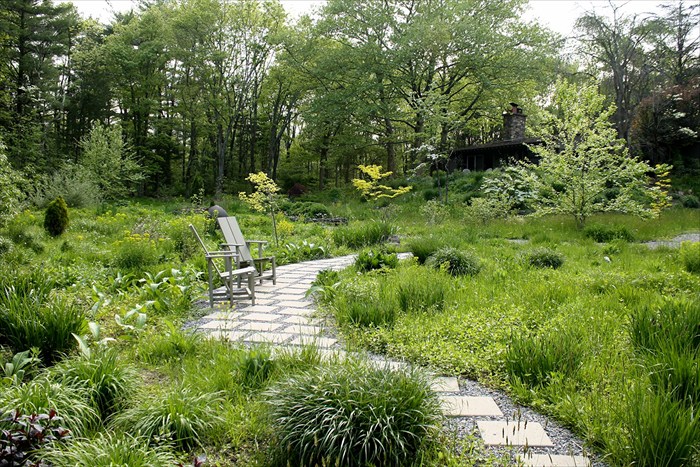 In nature, plants grow in communities, achieving an extraordinary level of integration over time. My goal is to create that kind of habitat in my garden, planting large numbers of individual plants in aesthetically pleasing drifts and bunches, with occasional areas of single or grouped vertical plantings. Over the years, I've continued to seed in different plants, to see what will grow in my conditions, and to increase diversity. Many native plants, particularly large numbers of carex, mosses, early spring ephemerals, arisaema, blue eyed grass, rushes, some native grasses, and other plants remain, adding to the diversity and complexity of the plantings.Here is a large community of Filipendula rubra 'Venusta', about 30 feet across, planted probably six years ago. A highly competitive plant, it remains vigorous and is kept in bounds by surrounding plants.
In nature, plants grow in communities, achieving an extraordinary level of integration over time. My goal is to create that kind of habitat in my garden, planting large numbers of individual plants in aesthetically pleasing drifts and bunches, with occasional areas of single or grouped vertical plantings. Over the years, I've continued to seed in different plants, to see what will grow in my conditions, and to increase diversity. Many native plants, particularly large numbers of carex, mosses, early spring ephemerals, arisaema, blue eyed grass, rushes, some native grasses, and other plants remain, adding to the diversity and complexity of the plantings.Here is a large community of Filipendula rubra 'Venusta', about 30 feet across, planted probably six years ago. A highly competitive plant, it remains vigorous and is kept in bounds by surrounding plants.
Here is another stable mixed planting of Iris pseudacorus, Lysimachia ciliata 'Firecracker', native irises, and other perennials not yet visible. Note the large, glaucous leaves of Rudbeckia maxima. Though these plants don't spread rapidly, they are highly resistant to their aggressive neighbors and appear to be long-term and healthy residents after almost seven years.
Below, two more very aggressive plants, Petasites hybridus x 'Dutch' and Pycnanthemum muticum, with a couple of self-seeded Inula racemosa, have also established a stable community.
Day lilies and Calamagrostis acutiflora 'Karl Foerester' in rough grass below. The Calamagrostis hasn't been invaded by the surrounding vegetation, as one might expect, perhaps because I burn the area every year. The day lilies continue to bloom year after year, then their foliage fades into the background (as I want).
An interesting story here. Equisetum arvense, which I find quite attractive, is rampant throughout this area. (It was present when we arrived, and there's no way to eliminate it.) I'm sure it has a retarding effect on some of the other plants, but the highly invasive Petasites needs to be controlled, and is.
I've also continued to seed in new plants and, as the ecology of the garden changes, different seeds find appropriate niches and take hold. Because I chop and burn, rather than removing the organic detritus, the accumulation of organic material from year to year is changing the soil conditions. More successful seeding is one result of this. In the future, conditions may change so much that the plant communities will evolve enough to require some dramatic intervention, perhaps not. I just need to remain observant, and learn to adapt to the arc and momentum the garden presents.
Back to those Fallen White Pines
So I've dealt with disturbance before, have even incorporated it as part of my garden management practice, and created a garden that, though not perfect or complete, satisfies me day by day. Now I'm deciding what to do, if anything, about those huge fallen White pines. These fallen trees, while a visual mess, have a creative role to play. First, I want to clean them up, cutting off the rough wood and slanting limbs to emphasize the horizontal monumentality of the remains.I imagine I'll be seeing seedling Sassafras in a few years, almost certainly poison ivy and Virginia Creeper. The large woodpecker population will soon be at work as the wood is invaded by insects and decay sets in. The fallen patch of forest will slowly regenerate, though I won't be here to see it reach maturity.As to effects on my garden, I wait to see. I'll have a southern sky for the first time, and much more light. I'm adding trees, shrubs, grasses, and herbaceous perennials to the hedgerow between the garden and the fallen trees to partly hide their bulk. I hope the brilliant light will help promote rapid growth of a protective screen. I don't know what the effects the brighter light and heat will have on existing plantings on the southern side of the garden, but the garden will adjust. I'll watch and intervene as needed.To make the meaning of the fallen trees clearer to visitors, I may ask some artist friends to help out. I'm thinking about taking some relevant words about ecological process from Beck's book--disturbance, change, adaptation, diversity, resilience--and painting, carving, or burning them into the fallen trunks in such a way that they remain in the background, yet can be read by those who want to see.
Afterword
This post is about a practical problem and how an understanding of the scientific discipline of ecology may help solve that problem. It has little to say about garden making as I know it, little to nothing about design to evoke or convey meaning, emotion, aesthetic intent, about the experience of the garden. If I were to point to a single key theme, it is the idea of the novel, or created ecosystem, and what that means for the garden of the future. In short, this is not the whole story, but an important chapter.


